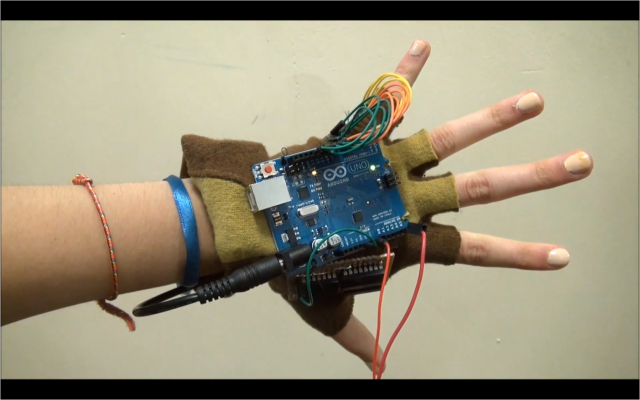Arduinolin
Arduinolin is a project designed to investigate the evolution of material possessions based on electronic trends by taking a traditional object and recreating a new object which is not only a modern, electrified version of the former but also extends the object using the capabilities of digital media.
Overview
I decided upon a violin as my “traditional object” of choice, mainly because I thought it would be reasonable to use a stringed object as the ability to reprogram the touch sensors on the gloves to play different pitches when activated supports my concept. I immediately researched the evolution the violin and the electronic violin, which is all documented in this previous blog post.
Inspiration
The concept was inspired by a conversation I had with my father one night. I was on the phone with him and he was talking about an app he had just purchased for his iPhone. What caught my attention was that he had actually paid over $3.oo for it – I am not in the habit of downloading an application unless it is free. That set me thinking, how many apps have you purchased? How much money have you spent on virtual material? Is it worth it? How will very highly valued items which gain value as they age be transferred into the electronic world, and will that transfer ever be successful?
There is also an ecological argument accompanying the evolutionary argument which entails comparing the carbon footprint of apps and actual instruments, and how this could all eventually be handled by a single piece of technology.
Technical Aspects
The bulk of the work in this project was in figuring out how I was going to wire touch sensitive capacitors and make them individually interactive to the human touch. I had considered going with something like a pressure sensor which would return a different value depending where on the strip pressure was applied but turned this down in favor of using materials which could easily be translated onto conductive fabric for the purpose of making the final product wearable. In retrospect, I greatly regret not pursuing the first option, which would have made for a much smoother transition between instruments and a greater degree of musicality.
Additionally, I was unsure of how I was going to wire everything together onto the glove. The palm of the hand alone features twenty four wires, all interwoven into the glove itself using conductive thread. In the end I did use jumper cables to transfer data from the individual pins to the glove, then touched the end of the jumper cable to the thread. From there, all the Arduino does is loop through each pin then for each pin loop through each note in an array and if the pin corresponds to the note, play the note. I also have some “fun” touchpads at the moment which loop through a series of notes.
Critical Reflection
There are many existing versions of this project ranging in degrees of professionalism from those hobbyist who work out of the garage to commercially marketed products (typically designed to help one learn an instrument). I see that there are few limits to the extent to which I could improve upon my project, at least in theory. However, there are two things I would like to improve upon more than anything else.
Firstly, I am greatly irritated by the fact that although I have two gloves, the left hand representing the violin and the right hand representing the bow, the right hand does not actually need to do anything for the violin to work. Although in principle placing an accelerometer on the right glove would not be difficult, convincing the accelerometer to communicate with the arduino might have been something of a challenge perhaps involving a wireless shield.
Secondly, I am not impressed by the sound quality at all. I understand that it is very possible to synthesize sounds using MaxMSP which would be a far more rewarding result than the current buzzes provided by the Piezo element. It would be also be very rewarding to have a proper headphone jack to output the audio. I enjoy the personal experience my current edition supplies, but would certainly enhance this wherever possible. (Sticking a Piezo buzzer in one’s hat does not necessarily result in the best audio.)